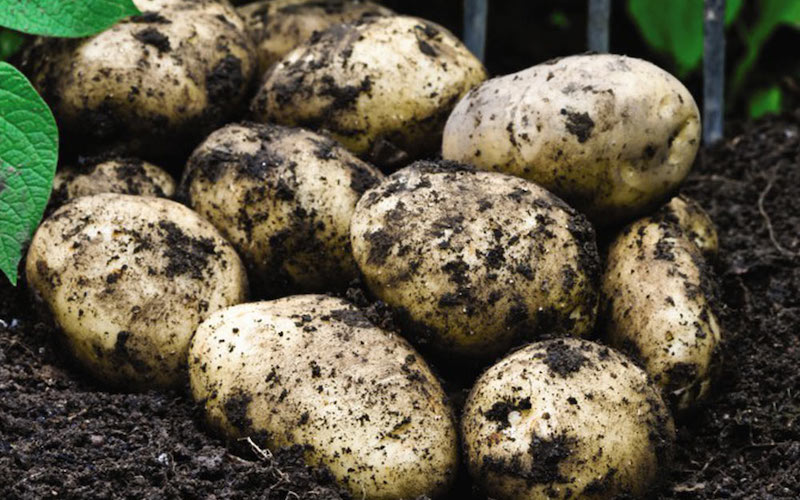To help you grow your own potatoes, we’ve assembled some of the best expert tips while busting some of the myths that make potato growing sound complicated. Potatoes are one of the easiest, most economical and most bountiful crops that any gardener can grow, whether you have a tiny balcony or the luxury of a large allotment.
Here’s your ultimate guide – from choosing the best seed potatoes through to harvesting and storing your spuds.
Contents
- Best advice on chitting potatoes
- Best advice on how to plant potatoes
- Best advice on how to grow potatoes in containers
- Best advice on when to plant potatoes
- Best advice on how to care for potato plants
- Best advice on how to harvest and store potatoes
- Best advice on potato growing problems and diseases
Best advice on chitting potatoes
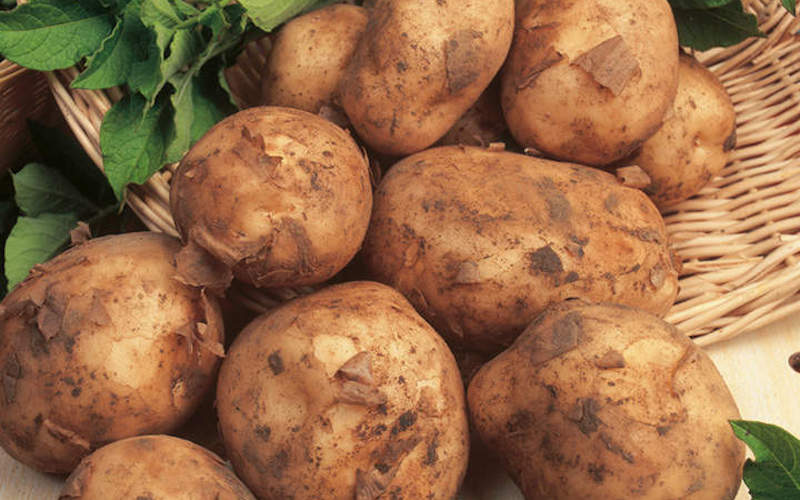
Image: Seed Potatoes ‘Duke of York’ from Suttons
Chitting simply means allowing shoots – or chits – to sprout from your seed potatoes before you plant them, as beautifully explained by Claire in her video over at Claire’s Allotment: ‘Holy chit, is it that time already?’ She says you should start the process four to six weeks before you want to plant.
If you want to give your early potatoes a head start, chitting is the answer, according to Alan at Down to Earth. As soon as they arrive from his supplier, he stands his first early seed potato tubers on their ends – usually in egg trays – on the windowsill and waits for dark, fat shoots to appear. For his super early crop, he then plants them in containers in the greenhouse until all frost danger has passed.
The ladies at The 3 Growbags have differing views on whether it’s necessary to chit your seed potatoes. In their chatty and inspirational beginners guide to growing potatoes, Elaine always chits hers because she likes to know the best way up to plant them. But Caroline, in her great video on planting potatoes in a raised bed, insists it’s just not necessary.
Anna @annagreenland offers a really clear, simple and concise video tutorial on how to chit potatoes ready for planting. She says you can pop your newly arrived seed potatoes into egg boxes and leave them somewhere light and cold, like an unheated greenhouse, until they start sprouting a couple of strong shoots. She doesn’t usually chit her own seed potatoes but says it’s a good way to store them until the time is right for planting.
Paulo the Urban Gardener is a firm no chitter! In his chatty video on potato growing he recalls a TV gardening experiment where chitted seed potatoes were grown alongside seed potatoes that were put straight into the ground and the yield was exactly the same. He has had great success without chitting ever since.
Best advice on how to plant potatoes
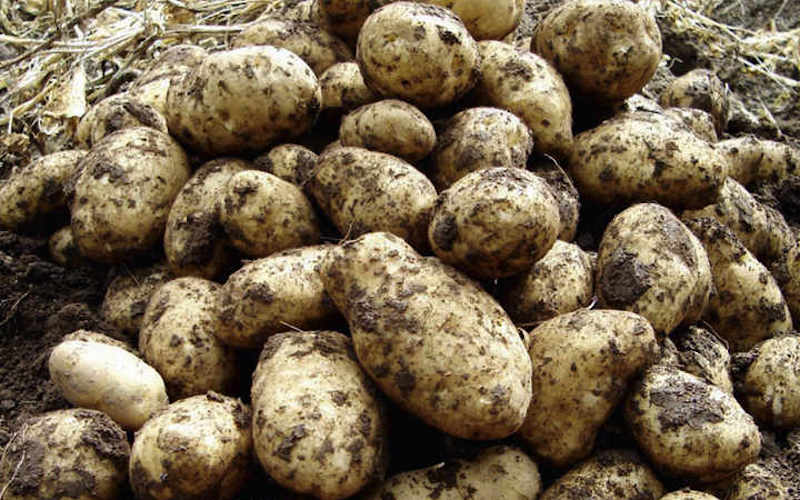
Image: Seed Potatoes – Arran Pilot from Suttons
The traditional open ground method is the tried and trusted path preferred by John Harrison of Allotment & Gardens, as detailed in his very thorough guide to growing potatoes. He prepares his soil well, digging it over and adding manure in winter, and removing any weeds in spring, before marking rows and allowing enough space between seed potatoes according to the variety.
An alternative ‘no dig’ method is to mulch seed potatoes with grass clippings and used chicken bedding, like Liz at Byther Farm. Her video shows how she pulls up as many weed roots as she can in a 3ft by 10ft bed, lays her seed potatoes on top and covers with a good 6in each of the grass and bedding, making sure no light gets through.
Mothin at My Family Garden shows us how he grows potatoes in woodchip, as part of a long-term plan to improve his soil and his potato harvest. While raking through the ground with his fingers to find mature potatoes, helped by his children, Mothin explains why woodchip is an excellent option, although his plants were affected by blight.
A beautiful basket of first early potatoes ready for the kitchen amply rewarded Becky’s decision to try the ‘no dig’ method over @sow_much_more. She simply laid the seed potatoes out on the allotment bed soil and covered them over; the roots grew out instead of down, making them really easy to harvest.
Potatoes are a great first crop for children, according to Katy of Katy in the Garden. Digging around to find the mature potatoes is a big part of the fun for little ones, like her son Arthur, so she recommends planting directly in the ground if possible. She says there’s no need to dig a trench; just make nice deep holes and let your child pop a seed potato into each one.
Best advice on how to grow potatoes in containers
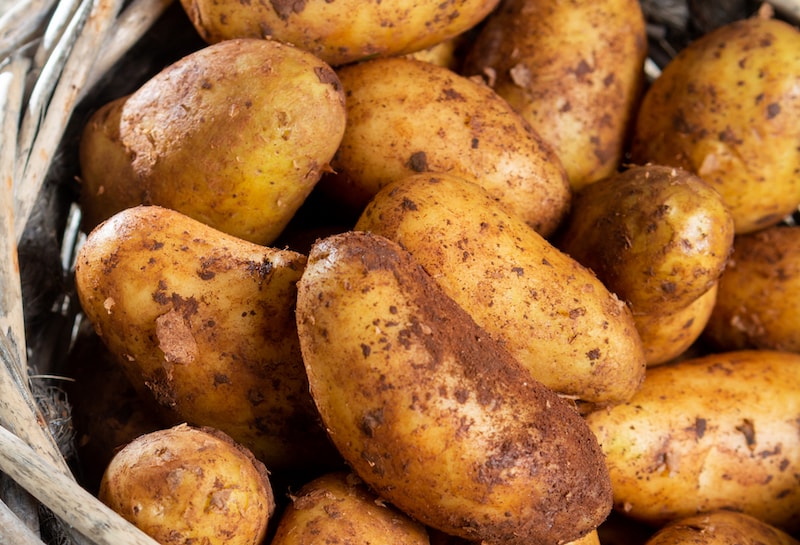
Image: Seed Potatoes ‘Nicola’ from Suttons
In her excellent step-by-step potato growing video, Katrina at Homegrown Garden explains why she chooses to grow all her potatoes in 20-litre containers on top of her allotment bed. Apart from avoiding the wireworm in her soil, she can move the pots around if the weather is too hot, too cold, or too wet. And at harvest time, there’s no potentially damaging digging involved – she just tips out the container.
Paulo the Urban Gardener explains what he considers the three elements needed for potato growing success – a rich, deep loamy soil, plenty of sunshine and a consistent water content. He likes to ensure these conditions by growing his crop in containers. Going large, he plants six seed potatoes in each of eight 40-litre pots in April, reporting a very satisfying 20kg harvest.
If you’re short on garden or allotment space, Tony at Simplify Gardening reckons growing your potato crop in containers is the best way to achieve the maximum harvest in the minimum area. His informative video reveals how he grew 235lb of potatoes in 48 containers in an area 20ft by 10ft – and that was in a bad year when illness prevented him from watering them. His usual yield is almost three times that amount.
Supermarket bags for life are great for growing potatoes, says Mark of Vertical Veg, master of cultivating his own crops in the tiniest space possible. He explains that you start with a rolled down bag filled with 20-30cm of compost, put in two or three seed potatoes, and cover with another 15cm of compost. As the plant grows, you progressively unroll the bag and keep earthing up around the plant stem.
Best advice on when to plant potatoes
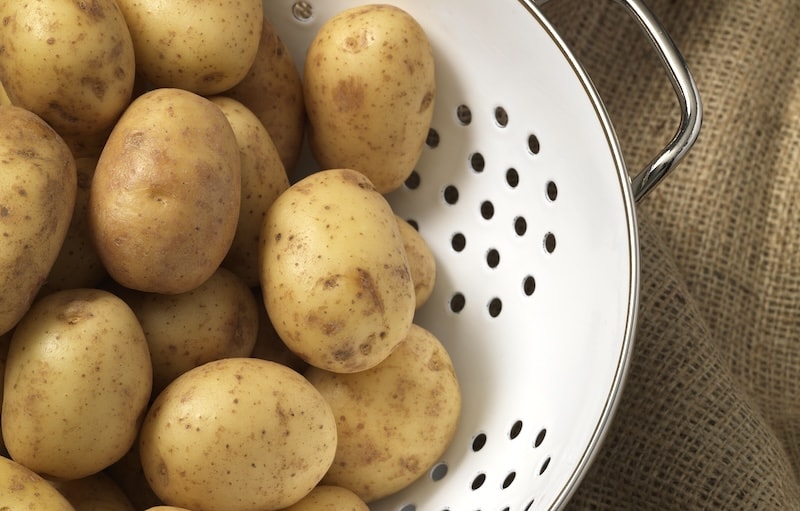
Image: Potato ‘Jacky’ from Suttons
When you plant your potatoes will depend on the variety you choose and when you want to harvest them, explains Carol, The Sunday Gardener, in her comprehensive guide to growing potatoes. As a general rule, first earlies should go into the ground or container in March or early April, followed by second earlies and finally the maincrop in late April. If you’re planting in the ground, place the potatoes around 13cm deep and 30cm apart.
For a delicious crop of homegrown new potatoes for Christmas lunch, Catherine at Growing Family explains how you can plant special late seed potatoes at the end of summer in bags or containers and grow them in a greenhouse or sheltered spot in the garden.
Best advice on how to care for potato plants
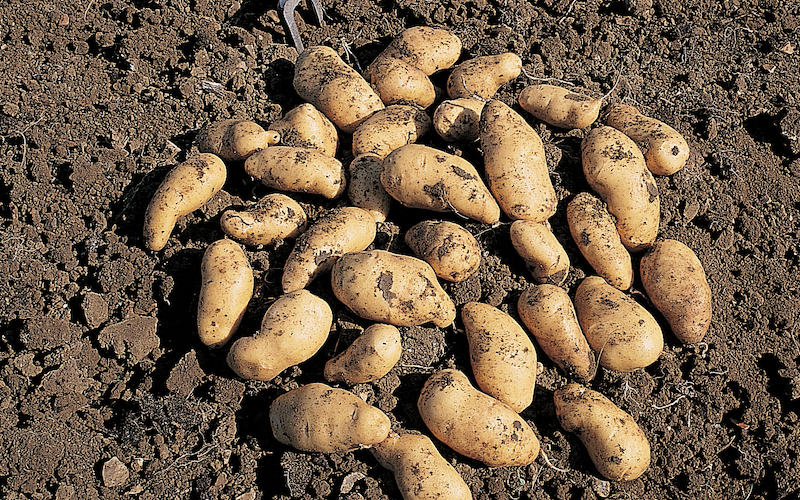
Image: Maincrop seed potatoes from Suttons
As your potato plants grow, Anna says it’s important to make sure the developing tubers are well covered. In her easy to watch video over @annagreenland, she demonstrates how to earth up your potato plants, whether they’re in the ground or containers. She draws soil up around the stems to protect the tubers underneath from frost which could kill them, or sunlight which could turn them green and potentially make them poisonous to eat.
Some folks reckon it’s best to remove flowers and fruits from potato plants to increase the crop, reveals Matt from @growlikegrandad. The idea is that more energy will go into producing tubers. To test the theory he did his own trial with eight Charlotte potato plants on the allotment, treating them in exactly the same way, apart from removing the flower buds. The result? Flowers removed: 37 potatoes weighing 3.83kg. Flowers left on: 40 potatoes weighing 4.12kg.
Best advice on how to harvest and store potatoes
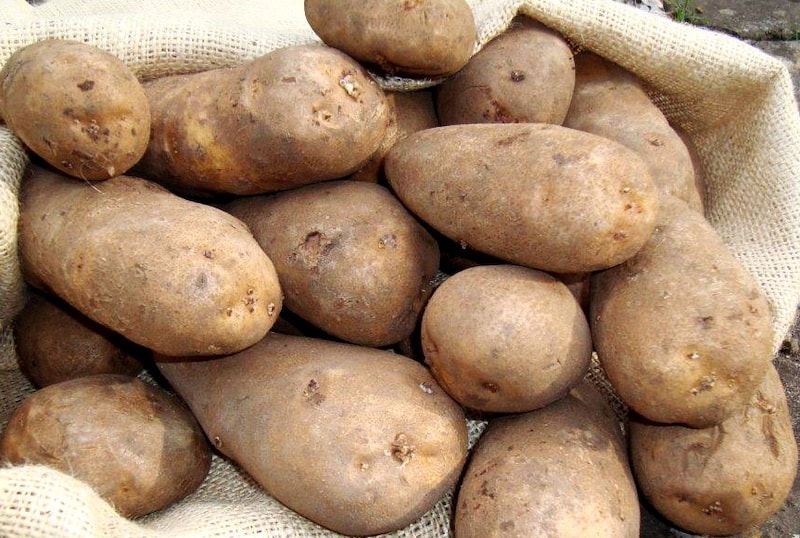
Image: Potato ‘Golden Wonder’ from Suttons
Bearing in mind differences between specific varieties, Catherine at Growing Family offers a rough timetable for harvesting potatoes. She says first earlies should be ready around 10 weeks after planting, second earlies three weeks longer, with the maincrops at their biggest and best after around 20 weeks in the ground.
Your potatoes won’t be ready to harvest until after they have flowered, says Carol, The Sunday Gardener. She suggests you check the growth of potato tubers by gently scraping away some earth to have a look. If the potatoes are still too small, cover them up and give them another week or two to develop.
If you want to save a good stock of potatoes to use through the autumn and winter, take great care when digging up and packing your crop, says Tony at Simplify Gardening. His video goes through the whole process, from digging techniques and curing the potatoes to stop them turning green, to several different approaches to longer term storage. Potato and hay lasagne, anyone?
Fully grown potatoes can happily sit in the ground for a while, as long as you get them up before the soil gets too cold, says Sarah in her informative post on when potatoes are ready over at Digging the Earth. She usually plants her main crop in April and harvests late summer and autumn, gradually taking what she needs for cooking, but pulling out all the potatoes to store by November.
If you’re growing potatoes in the ground, you don’t have to harvest the whole crop from each plant all at once. Debbie @mrsbeesgarden went to earth up her potato plants and rummaged around gently, close to the surface to find these beautiful early potato specimens, just six weeks after planting.
Best advice on potato growing problems and diseases
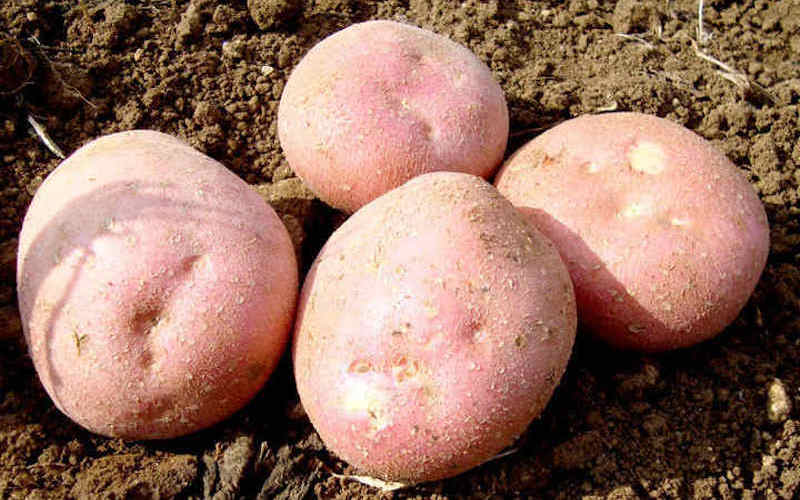
Image: ‘Caledonian Rose’ Seed Potatoes from Suttons
Blight is the main hazard for potato growers and John at Allotment & Gardens offers very helpful and detailed advice about how to recognise, prevent and deal with this fungal disease that can cause swift devastation. It spreads via airborne spores and prefers warm, humid weather. One answer is to grow more blight resistant varieties.
Jessie at Plot 37 reports a sad maincrop potato failure caused by a combination of poor soil, early cold weather, early flowering, plus terrible slug damage and cases of potato scab. Her solution is to add a lot of green manure to the allotment bed to improve the soil, and growing potatoes in old compost bags for the time being.
Scab can be a problem for some potato growers, especially if the soil dries out. Carol at The Sunday Gardener explains that their skins might look unattractive, but peel them and they’re still edible. She recommends adding organic matter to thinner soils to help retain water.
There’s no doubt that potatoes are an incredibly versatile crop that can be grown in many locations and conditions, and with the minimum of fuss. With so much excellent expert advice to guide you, all you need to do is decide which potato varieties you’d like to grow in the coming year!
Lead image: Potato Orla from Suttons/Copyright: Alamy Stock Photo
See expert contributors here
- Claire Burgess, Gardening writer, blogger, author, YouTuber.
- Alan Down, Garden writer, blogger, radio & TV consultant. President of the HTA.
- The 3 Grow Bags, Gardening bloggers, YouTubers and authors.
- Anna Greenland, Gardening influencer, author, gold medallist at Hampton Court Flower Show 2018.
- Paulo Nicolaides, self sufficient homesteader, blogger and YouTuber.
- John Harrison, Allotment blogger, author and garden writer.
- Liz Zorab, Blogger, YouTuber, gardener and author. Winner GMG Vlog of the Year 2022.
- Mothin Ali, YouTube content creator and influencer, garden homesteader.
- Becky Searle, Ecologist, gardener and freelance garden writer.
- Katy Watson, RHS Level 3 & Garden Design Diploma. Garden designer and writer.
- Katrina Harrison, Gardener, YouTube content creator, and blogger.
- Tony O’Neill, Gardening content creator. Winner Ezoic Publisher of the Year award 2021.
- Carol Bartlett, Gardening blogger and content creator.
- Catherine Hughes, Freelance journalist and writer, author.
- Matt Peskett, Agritech Publisher & Digital Consultant. Allotment chair and RHS volunteer.
- Sarah Taffe, Organic gardener & blogger, writer and columnist.
- Debbie Beech, Gardening content creator.
- Jessie Sheffield, Allotment gardener, YouTube content creator and influencer.
- Mark Ridsdill Smith, Garden writer, author. Winner GMG The Peter Seabrook Practical Book of the Year 2022.
Last Updated on April 24, 2025 by Suttons Horticultural Team

